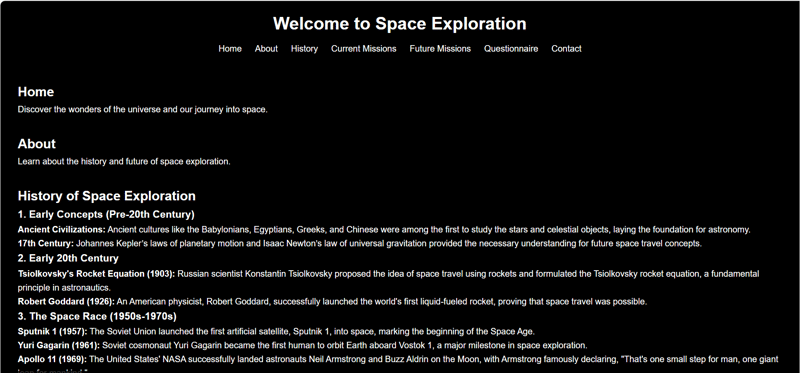前端嘗試
這是前端挑戰 v24.09.04 的提交內容,美化我的標記:Space
我建造了什麼
我建立了一個以太空為主題的登陸頁面,提供有關太空探索的資訊。目標是創造一個有吸引力的簡約設計,突出太空歷史、當前任務、未來任務等的關鍵方面。此頁麵包括主頁、關於、歷史、當前任務、未來任務、問捲和聯絡資訊等部分。
示範
您可以在此處即時查看該項目。以下是登陸頁面的螢幕截圖:

太空探索登陸頁
您也可以在Github上查看程式碼
旅程
創建這個專案是一次令人興奮的旅程。以下是有關該過程的一些要點:
設計和佈局:我的目標是乾淨簡約的設計,帶有黑暗的太空主題背景,以創造身臨其境的體驗。佈局簡單但資訊豐富,使用戶可以輕鬆瀏覽不同的部分。
內容:我包含了有關太空探索歷史、當前和未來任務的詳細資訊。問卷部分允許使用者互動並分享他們對太空探索的想法。
挑戰:挑戰之一是確保動畫互動在不同裝置和螢幕尺寸上順利運作。在這個過程中我學到了很多關於響應式設計和跨瀏覽器相容性的知識。
未來計畫:我計劃增加更多互動元素,例如有關太空事實的測驗和太空探索中重大事件的時間表。我也希望整合更進階的動畫和轉場,讓頁面更吸引人。
程式碼
HTML
<!DOCTYPE html>
<html lang="en">
<head>
<meta charset="UTF-8">
<meta name="viewport" content="width=device-width, initial-scale=1.0">
<title>Space Exploration</title>
<link rel="stylesheet" href="styles.css">
</head>
<body>
<header class="space-background">
<h1>Welcome to Space Exploration</h1>
<nav>
<ul>
<li><a href="#home">Home</a></li>
<li><a href="#about">About</a></li>
<li><a href="#history">History</a></li>
<li><a href="#current-missions">Current Missions</a></li>
<li><a href="#future-missions">Future Missions</a></li>
<li><a href="#questionnaire">Questionnaire</a></li>
<li><a href="#contact">Contact</a></li>
</ul>
</nav>
</header>
<main class="space-background">
<section id="home">
<h2>Home</h2>
<p>Discover the wonders of the universe and our journey into space.</p>
</section>
<section id="about">
<h2>About</h2>
<p>Learn about the history and future of space exploration.</p>
</section>
<section id="history">
<h2>History of Space Exploration</h2>
<h3>1. Early Concepts (Pre-20th Century)</h3>
<p><strong>Ancient Civilizations:</strong> Ancient cultures like the Babylonians, Egyptians, Greeks, and Chinese were among the first to study the stars and celestial objects, laying the foundation for astronomy.</p>
<p><strong>17th Century:</strong> Johannes Kepler’s laws of planetary motion and Isaac Newton’s law of universal gravitation provided the necessary understanding for future space travel concepts.</p>
<h3>2. Early 20th Century</h3>
<p><strong>Tsiolkovsky's Rocket Equation (1903):</strong> Russian scientist Konstantin Tsiolkovsky proposed the idea of space travel using rockets and formulated the Tsiolkovsky rocket equation, a fundamental principle in astronautics.</p>
<p><strong>Robert Goddard (1926):</strong> An American physicist, Robert Goddard, successfully launched the world's first liquid-fueled rocket, proving that space travel was possible.</p>
<h3>3. The Space Race (1950s-1970s)</h3>
<p><strong>Sputnik 1 (1957):</strong> The Soviet Union launched the first artificial satellite, Sputnik 1, into space, marking the beginning of the Space Age.</p>
<p><strong>Yuri Gagarin (1961):</strong> Soviet cosmonaut Yuri Gagarin became the first human to orbit Earth aboard Vostok 1, a major milestone in space exploration.</p>
<p><strong>Apollo 11 (1969):</strong> The United States' NASA successfully landed astronauts Neil Armstrong and Buzz Aldrin on the Moon, with Armstrong famously declaring, "That's one small step for man, one giant leap for mankind."</p>
<h3>4. Post-Moon Landings and the Space Shuttle Era (1970s-1990s)</h3>
<p><strong>Space Stations:</strong></p>
<ul>
<li><strong>Salyut and Mir (1971-1986):</strong> The Soviet Union launched a series of space stations, culminating in the long-lasting Mir, which operated until 2001.</li>
<li><strong>Skylab (1973):</strong> The United States launched its first space station, Skylab, which was operational for six years.</li>
</ul>
<p><strong>Space Shuttle Program (1981-2011):</strong> NASA’s reusable Space Shuttle fleet completed 135 missions over 30 years, including launching satellites, conducting scientific research, and assembling the International Space Station (ISS).</p>
<h3>5. International Cooperation and Space Exploration (1990s-Present)</h3>
<p><strong>International Space Station (ISS) (1998-present):</strong> A joint effort by NASA, Roscosmos (Russia), ESA (Europe), JAXA (Japan), and other partners, the ISS serves as a hub for scientific research and international collaboration in low Earth orbit.</p>
<p><strong>Mars Exploration:</strong></p>
<ul>
<li><strong>Rovers and Orbiters:</strong> The Mars rovers like Spirit, Opportunity, Curiosity, and Perseverance have provided detailed information about the Martian surface and its potential to support life.</li>
<li><strong>ExoMars (2020):</strong> A European-Russian mission designed to search for signs of life on Mars.</li>
</ul>
<h3>6. Private Space Exploration and the Future (2000s-Present)</h3>
<p><strong>Commercial Spaceflight:</strong> Companies like SpaceX, Blue Origin, and Virgin Galactic are pioneering commercial space travel, aiming to make space more accessible to private individuals and researchers.</p>
</section>
<section id="current-missions">
<h2>Current Missions</h2>
<p>Explore the ongoing missions that are expanding our understanding of the universe.</p>
</section>
<section id="future-missions">
<h2>Future Missions</h2>
<p>Learn about the upcoming missions that aim to push the boundaries of space exploration.</p>
</section>
<section id="questionnaire">
<h2>Questionnaire</h2>
<form>
<label for="name">Name:</label>
<input type="text" id="name" name="name" required><br><br>
<label for="email">Email:</label>
<input type="email" id="email" name="email" required><br><br>
<label for="question1">1. What is your favorite planet?</label><br>
<input type="text" id="question1" name="question1" required><br><br>
<label for="question2">2. Have you ever visited a space museum?</label><br>
<input type="radio" id="yes" name="question2" value="yes">
<label for="yes">Yes</label><br>
<input type="radio" id="no" name="question2" value="no">
<label for="no">No</label><br><br>
<label for="question3">3. What interests you the most about space exploration?</label><br>
<textarea id="question3" name="question3" rows="4" cols="50" required></textarea><br><br>
<input type="submit" value="Submit">
</form>
</section>
<section id="contact">
<h2>Contact</h2>
<p>Get in touch with us for more information about space exploration.</p>
</section>
</main>
<footer class="space-background">
<p>© 2024 Space Exploration. All rights reserved.</p>
</footer>
</body>
</html>
CSS
* {
margin: 0;
padding: 0;
box-sizing: border-box;
}
body {
font-family: Arial, sans-serif;
line-height: 1.6;
background-color: #000;
color: #fff;
}
.space-background {
background: rgba(0, 0, 0, 0.8) url('https://www.nasa.gov/sites/default/files/thumbnails/image/potw2048a.jpg') no-repeat center center;
background-size: cover;
}
header {
padding: 1rem 0;
text-align: center;
}
header h1 {
margin-bottom: 0.5rem;
}
nav ul {
list-style: none;
padding: 0;
}
nav ul li {
display: inline;
margin: 0 10px;
}
nav ul li a {
color: #fff;
text-decoration: none;
}
main {
padding: 2rem;
}
section {
margin-bottom: 2rem;
}
form {
background: rgba(255, 255, 255, 0.1);
padding: 1rem;
border-radius: 5px;
}
form label {
display: block;
margin-bottom: 0.5rem;
}
form input[type="text"],
form input[type="email"],
form textarea {
width: 100%;
padding: 0.5rem;
margin-bottom: 1rem;
border: none;
border-radius: 5px;
}
form input[type="submit"] {
background: #333;
color: #fff;
border: none;
padding: 0.5rem 1rem;
border-radius: 5px;
cursor: pointer;
}
form input[type="submit"]:hover {
background: #555;
}
footer {
text-align: center;
padding: 1rem 0;
position: fixed;
width: 100%;
bottom: 0;
}
團隊
這個專案是一個人的努力,但我想歸功於以下資源和靈感:
NASA 令人驚嘆的太空影像。
MDN Web 文檔,提供有關 Web 開發的優秀文檔。
許可證
該專案根據 MIT 許可證獲得許可。請隨意使用和修改您認為合適的程式碼。
以上是前端嘗試的詳細內容。更多資訊請關注PHP中文網其他相關文章!

熱AI工具

Undresser.AI Undress
人工智慧驅動的應用程序,用於創建逼真的裸體照片

AI Clothes Remover
用於從照片中去除衣服的線上人工智慧工具。

Undress AI Tool
免費脫衣圖片

Clothoff.io
AI脫衣器

Video Face Swap
使用我們完全免費的人工智慧換臉工具,輕鬆在任何影片中換臉!

熱門文章

熱工具

記事本++7.3.1
好用且免費的程式碼編輯器

SublimeText3漢化版
中文版,非常好用

禪工作室 13.0.1
強大的PHP整合開發環境

Dreamweaver CS6
視覺化網頁開發工具

SublimeText3 Mac版
神級程式碼編輯軟體(SublimeText3)
 Python vs. JavaScript:學習曲線和易用性
Apr 16, 2025 am 12:12 AM
Python vs. JavaScript:學習曲線和易用性
Apr 16, 2025 am 12:12 AM
Python更適合初學者,學習曲線平緩,語法簡潔;JavaScript適合前端開發,學習曲線較陡,語法靈活。 1.Python語法直觀,適用於數據科學和後端開發。 2.JavaScript靈活,廣泛用於前端和服務器端編程。
 JavaScript和Web:核心功能和用例
Apr 18, 2025 am 12:19 AM
JavaScript和Web:核心功能和用例
Apr 18, 2025 am 12:19 AM
JavaScript在Web開發中的主要用途包括客戶端交互、表單驗證和異步通信。 1)通過DOM操作實現動態內容更新和用戶交互;2)在用戶提交數據前進行客戶端驗證,提高用戶體驗;3)通過AJAX技術實現與服務器的無刷新通信。
 JavaScript在行動中:現實世界中的示例和項目
Apr 19, 2025 am 12:13 AM
JavaScript在行動中:現實世界中的示例和項目
Apr 19, 2025 am 12:13 AM
JavaScript在現實世界中的應用包括前端和後端開發。 1)通過構建TODO列表應用展示前端應用,涉及DOM操作和事件處理。 2)通過Node.js和Express構建RESTfulAPI展示後端應用。
 了解JavaScript引擎:實施詳細信息
Apr 17, 2025 am 12:05 AM
了解JavaScript引擎:實施詳細信息
Apr 17, 2025 am 12:05 AM
理解JavaScript引擎內部工作原理對開發者重要,因為它能幫助編寫更高效的代碼並理解性能瓶頸和優化策略。 1)引擎的工作流程包括解析、編譯和執行三個階段;2)執行過程中,引擎會進行動態優化,如內聯緩存和隱藏類;3)最佳實踐包括避免全局變量、優化循環、使用const和let,以及避免過度使用閉包。
 Python vs. JavaScript:社區,圖書館和資源
Apr 15, 2025 am 12:16 AM
Python vs. JavaScript:社區,圖書館和資源
Apr 15, 2025 am 12:16 AM
Python和JavaScript在社區、庫和資源方面的對比各有優劣。 1)Python社區友好,適合初學者,但前端開發資源不如JavaScript豐富。 2)Python在數據科學和機器學習庫方面強大,JavaScript則在前端開發庫和框架上更勝一籌。 3)兩者的學習資源都豐富,但Python適合從官方文檔開始,JavaScript則以MDNWebDocs為佳。選擇應基於項目需求和個人興趣。
 Python vs. JavaScript:開發環境和工具
Apr 26, 2025 am 12:09 AM
Python vs. JavaScript:開發環境和工具
Apr 26, 2025 am 12:09 AM
Python和JavaScript在開發環境上的選擇都很重要。 1)Python的開發環境包括PyCharm、JupyterNotebook和Anaconda,適合數據科學和快速原型開發。 2)JavaScript的開發環境包括Node.js、VSCode和Webpack,適用於前端和後端開發。根據項目需求選擇合適的工具可以提高開發效率和項目成功率。
 C/C在JavaScript口譯員和編譯器中的作用
Apr 20, 2025 am 12:01 AM
C/C在JavaScript口譯員和編譯器中的作用
Apr 20, 2025 am 12:01 AM
C和C 在JavaScript引擎中扮演了至关重要的角色,主要用于实现解释器和JIT编译器。1)C 用于解析JavaScript源码并生成抽象语法树。2)C 负责生成和执行字节码。3)C 实现JIT编译器,在运行时优化和编译热点代码,显著提高JavaScript的执行效率。
 Python vs. JavaScript:比較用例和應用程序
Apr 21, 2025 am 12:01 AM
Python vs. JavaScript:比較用例和應用程序
Apr 21, 2025 am 12:01 AM
Python更適合數據科學和自動化,JavaScript更適合前端和全棧開發。 1.Python在數據科學和機器學習中表現出色,使用NumPy、Pandas等庫進行數據處理和建模。 2.Python在自動化和腳本編寫方面簡潔高效。 3.JavaScript在前端開發中不可或缺,用於構建動態網頁和單頁面應用。 4.JavaScript通過Node.js在後端開發中發揮作用,支持全棧開發。






